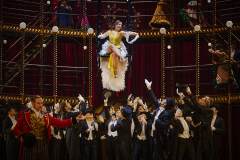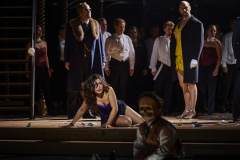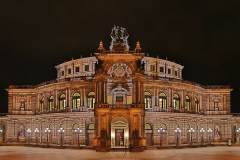La Traviata
Mo | Tu | We | Th | Fr | Sa | Su |
La Traviata - Giuseppe Verdi
Melodramma in three acts
Libretto by Francesco Maria Piave
Performed in Italian with German and English surtitles
Premiere: October 2, 2022
Has pain ever sounded more beautiful than in Verdi’s La traviata?
Storyline
Act one
Violetta Valéry is one of the most beautiful and most adored ladies in the Parisian demi-monde, who gives lavish parties in her salon and celebrates life itself. The young Alfredo Germont is also present at one of these celebrations and is asked by the hostess to offer a toast. He sings the praises of love, but is unable to impress Violetta much at first. She finds her greatest happiness in sensory indulgence and other simple pleasures of life. When the company rise to dance, Violetta, who is suffering from consumption, has a fainting spell and is forced to stay behind. Alfredo remains with her and declares his love for her. He asks her when he can come back, and Violetta gives him her favorite flower, a camellia. She tells Alfred to come back when the flower has withered. When he has gone, Violetta is left alone with her conflicting feelings. On the one hand, she loves this life of pleasure and freedom, but at the same time longs for a close bond with a person and a life away from the superficial Parisian society.
Act two
Violetta and Alfredo have become a couple and they are enjoying a happy time in the countryside near Paris. Alfredo learns from Annina, Violetta’s servant, that Violetta intends to sell valuables in order to further finance their happiness together at the country home. Alfredo decides to travel to Paris himself to find the necessary money. As soon as he is gone, a man appears in Violetta’s house whom she initially takes to be the buyer of her country home and who reveals himself to be Alfredo’s father, Giorgio Germont. Giorgio forcefully demands that Violetta end her love affair with his son. Alfredo’s sister’s groom threatens to break off their engagement if Alfredo doesn’t separate from her. Violetta decides to sacrifice her own happiness for someone else’s. When Alfredo returns, she evades him and secretly leaves for Paris, reappearing in society that evening at her friend Flora’s ball. She sends Alfredo a letter telling him that she has decided to break up with him. Alfredo is stunned. When he finds Flora’s invitation, he too, enraged with jealousy, sets out for Paris in order to confront Violetta. He meets her at the ball side by side with her former lover, Baron Douphal, whom she pretends to love dearly. Alfredo challenges the baron to a duel and, in front of the guests, throws a wad of money in Violetta’s face as payment for her »priceless services«. Violetta collapses. All protestations of her love for Alfredo and Alfredo’s rebuke by his father are in vain. After the duel with Douphal, Alfredo has to flee abroad.
Act three
Violetta’s will to live is broken. Alone and dying, she lives in her Paris apartment. When Alfredo learns from his father the real reasons behind Violetta’s separation, he immediately hurries back to Paris to her sickbed. In despair, he asks her forgiveness. Overwhelmed by his love, Violetta recovers for a moment. But it is too late. As a farewell, she hands him a locket with her picture on it and dies in his arms. Alfredo remains with his father in remorse and despair.
Program and cast
Violetta Valéry: Tuuli Takala (November 9, 14, 16, 20, 23, 29, 2024), Emily Pogorelc (January 11, 15, 18, 22, 25, 2025)
Alfredo Germont: Piotr Buszewski (November 9, 14, 16, 20, 23, 29, 2024), Bekhzod Davronov (January 11, 15, 18, 22, 25, 2025)
Giorgio Germont: James Rutherford (November 9, 14, 16, 20, 23, 29, 2024), Christoph Pohl (January 11, 15, 18, 22, 25, 2025)
Flora Bervoix: Nicole Chirka (November 9, 14, 16, 20, 23, 29, 2024), Štěpánka Pučálková (January 11, 15, 18, 22, 25, 2025)
Gastone: Simeon Esper (November 9, 14, 16, 20, 23, 2024, January 11, 15, 18, 22, 25, 2025), Patrick Vogel (November 29, 2024)
Barone Douphol: Csaba Sándor
Marchese d'Obigny: Vladyslav Buyalskiy
Dottore Grenvil: Martin-Jan Nijhof
Annina: Fernanda Allande
Giuseppe, Violetta's servant: Ingolf Stollberg-da Silva (November 9, 16, 23, 2024, January 11, 15, 18, 22, 25, 2025), Frank Blümel (November 14, 20, 29, 2024, January 11, 15, 18, 22, 25, 2025)
Servant of Flora: Wooram Lim (November 9, 16, 23, 2024, January 11, 15, 18, 22, 25, 2025), Reinhold Schreyer-Morlock (November 14, 20, 29, 2024, January 11, 15, 18, 22, 25, 2025)
Servant: Alexander Födisch (November 9, 16, 23, 2024, January 11, 15, 18, 22, 25, 2025), Holger Steinert (November 14, 20, 29, 2024, January 11, 15, 18, 22, 25, 2025)
Musical Direction: Marta Gardolińska (November 9, 14, 16, 23, 29, 2024), Stefano Ranzani (November 20, 2024), Gaetano d’Espinosa (January 11, 15, 18, 22, 25, 2025)
Production: Barbora Horáková Joly
Set Design: Eva-Maria van Acker
Costumes: Annemarie Bulla
Lighting: Fabio Antoci
Video: Sarah Derendinger
Choreography: Juanjo Arqués
Choir: Jan Hoffmann
Dramaturgy: Juliane Schunke
Saxon State Opera Choir Dresden
Saxon State Orchestra Dresden
Semperoper Dresden
The Semperoper is the opera house of the Sächsische Staatsoper Dresden (Saxon State Opera) and the concert hall of the Sächsische Staatskapelle Dresden (Saxon State Orchestra). It is also home to the Semperoper ballet. The building is located near the Elbe River in the historic centre of Dresden, Germany.
The opera house was originally built by the architect Gottfried Semper in 1841. After a devastating fire in 1869, the opera house was rebuilt, partly again by Semper, and completed in 1878. The opera house has a long history of premieres, including major works by Richard Wagner and Richard Strauss.
The first opera house at the location of today's Semperoper was built by the architect Gottfried Semper. It opened on 13 April 1841 with an opera by Carl Maria von Weber. The building style itself is debated among many, as it has features that appear in three styles; Early Renaissance and Baroque, with Corinthian style pillars typical of Greek classical revival. Perhaps the most suitable label for this style would be eclecticism, where influences from many styles are used, a practice most common during this period. Nevertheless, the opera building, Semper's first, is regarded as one of the most beautiful European opera houses.

 EN
EN DE
DE IT
IT FR
FR ES
ES RU
RU JP
JP RO
RO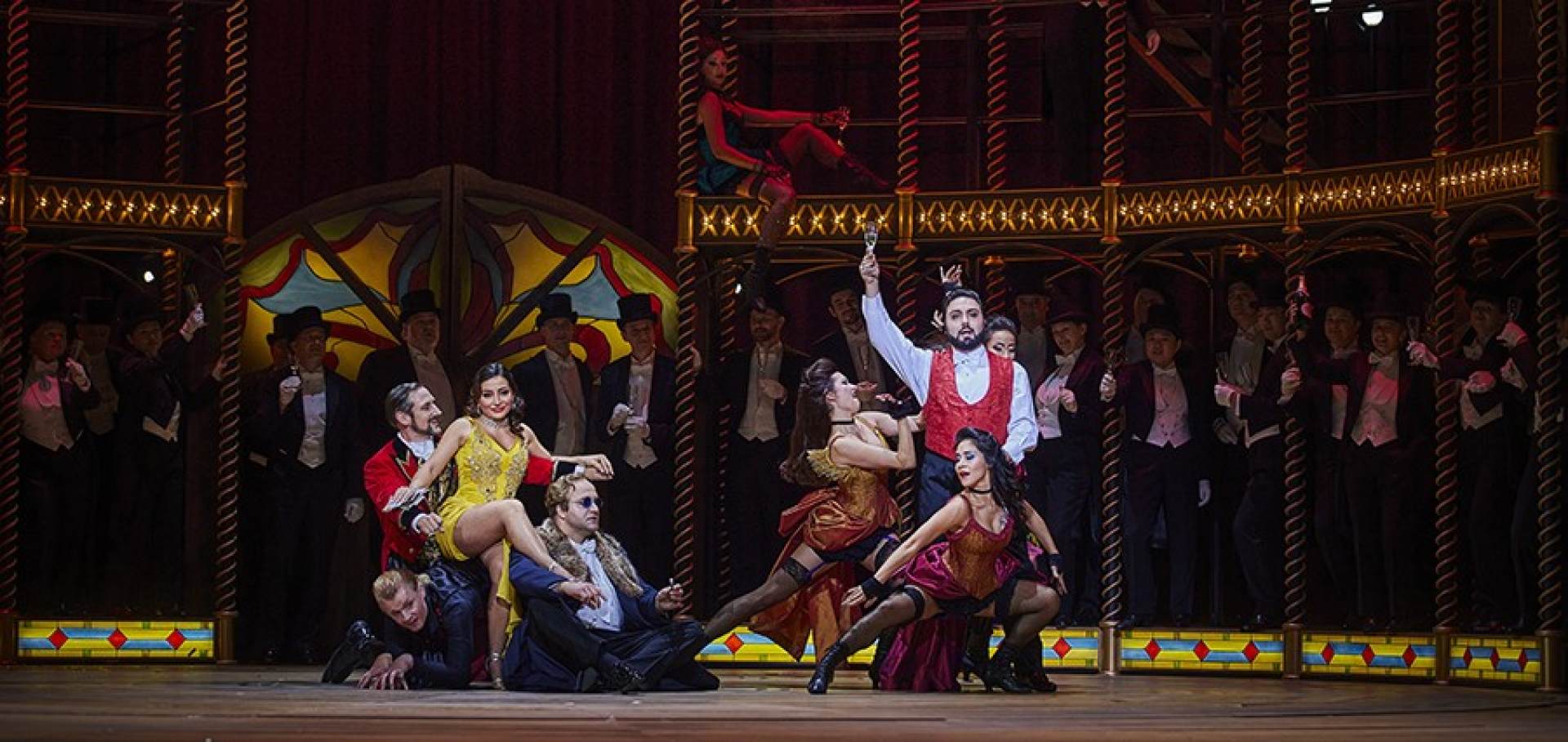
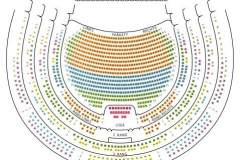 Seating plan
Seating plan 
